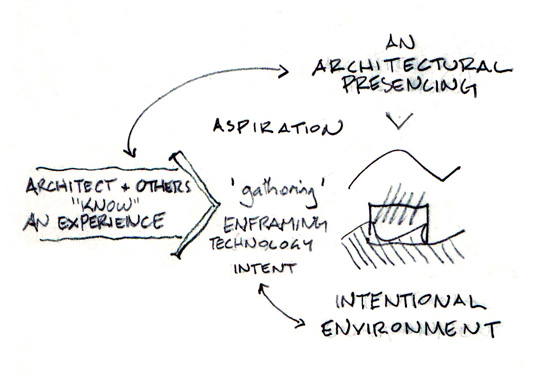| Introduction An unspoken issue of increasing priority in architectural education is that of the importance of differentiation between architecture and technology. Architecture remains inconsequentially differentiated from technology. This paper will introduce a relationship between spirituality, phenomenology and technology within architectural practice and integrate these with the conflict that architecture faces with technic. A fundamental human questioning is borne in that interaction. This paper proposes a space for that interaction that may be claimed by the architectural profession. That space is itself the realm of the super-ordinate purpose of work in the intentional environments of the world by which architecture comes to exist. This space is not simply about differentiating architect’s tasks from technical tasks, nor is it of specific definitions of differentiation between architecture and technology. The question is, however, manifested pointedly by that interaction of architecture and technology, which is actively pointing us in a subtler direction. This brings that space essential to architecture into view: one where the life of architecture — its root — can be traced out anew. |

The qualifications an architect prepares and by which the architect is permitted to practice professionally are almost exclusively technological parameters. We are naming ourselves and credentialing ourselves for the right to practice architecture professionally with evidence of technological ability. Once legitimized as architects we are free to define architecture in education, in our practice, research as well as with each project. It may seem enough to provide environments that effect lives materially, but that begs the issue of why architecture would then exist at all. What are the implications that evince this question in practice?
The perceptions of practice that Dana Cuff (Cuff 1991) and Robert Gutmann (Gutmann 2010) developed are bound up with this issue. Those insights have in the mean time turned from being factors for consideration in successful practice to a symptomology of the profession. Education has spent long enough attempting to generate graduates that supersede those problems to verify a lack of adequate results.
The well known theoretical and practical examples around the work of Heidegger and Louis I. Kahn as proposed by Christian Norberg-Schulz among others, make for a useful beginning. Norberg- Schulz specifically mentions education.
| To
disclose the world again, we have to return “to the things,
themselves,” because the world is known through the gathering of
things. A return to the things themselves demands a phenomenological
approach. Thus phenomenology ought to become the gathering middle of
education. (Norberg-Schulz 1979:46) |
philosophical intentions. Heidegger expresses the disclosing ‘gathering’ of dwelling in Building
Dwelling Thinking using a bridge as an example of such revealing. TALK
| The bridge gathers to itself in its own way earth and sky, divinities and mortals. (Heidegger 1971:151) |

That questioning can be traced back toward its origin through spirituality in its literature and arts over millennia (Larson 2008). Pure phenomenology is — in turn — remarkably similar to spiritual practice, using the same human facilities. Thus Norberg-Schulz’s approach, limited as it is, develops a threshold and we will take a step further including spirituality as the modus that answers the questioning grounds.